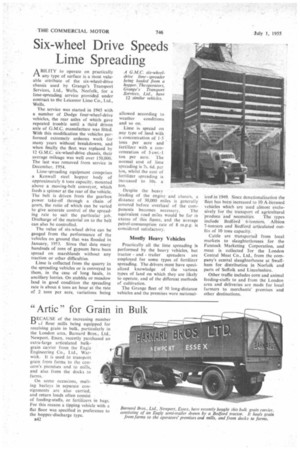Six-wheel Drive Speeds Lime Spreading
Page 92

If you've noticed an error in this article please click here to report it so we can fix it.
ABILITY to operate on practically any type of surface is a most valuable attribute of the six-wheel-drive chassis used by Grange's Transport Services, Ltd., Wells, Norfolk, for a lime-spreading service provided under contract to the Leicester Lime Co., Ltd., Wells.
The service was started in 1945 with a number of Dodge four-wheel-drive vehicles, the rear axles of which gave repeated trouble until a third driven axle of G.M.C. manufacture was fitted. With this modification the vehicles performed extremely arduous work for many years without breakdowns, and when finally the fleet was replaced by 12 G.M.C. six-wheel-drive chassis, their average mileage was well over 150,000. The last was removed from service in December. 1954.
Lime-spreading equipment comprises a Kenwall steel hopper body of approximately 6 tons capacity, mounted above a moving-belt conveyor, which feeds a spinner at the rear of the vehicle. The belt is driven from the gearbox power take-off through a chain of gears, the ratio of which can be varied to give accurate control of the spreading rate to suit the particular job. Discharge of the material on to the belt can also be controlled.
The value of six-wheel drive can be gauged from the performance of the vehicles on ground that was flooded in January, 1953. Since that date many hundreds of tons of gypsum have been spread on marshlands without any traction or other difficulties.
Lime is collected from the quarry in the spreading vehicles or is conveyed to them, in the case of long hauls, in ancillary lorries. On stubble or meadow land in good condition the spreading rate is about 6 tons an hour at the rate of 2 tons per acre, variations being allowed according to weather conditions and so on.
Lime is spread on any type of land with a concentration of 1-5 tons per acre and fertilizer with a concentration of 5 cwt.-1 ton per acre. The normal cost of lime spreading is 7s. hd. per ton, whilst the cost of fertilizer spreading is increased to 10s. a ton.
Despite the heavy loading of the engine and chassis, a distance of 30,000 miles is generally covered before overhaul of the com ponents becomes necessary. The equivalent road miles would be far in excess of this figure, and the average petrol-consumption rate of 8 m.p.g. is considered satisfactory.
Mostly Heavy Vehicles
Practically all the lime spreading is performed by the heavy vehicles, but tractor and trailer spreaders are employed for some types of fertilizer spreading. The drivers must have specialized knowledge of the various types of land on which they are likely to operate, and of the different methods of cultivation.
The Grange fleet of 50 long-distance vehicles and the premises were national
ized in 1949. Since denationalization the fleet has been increased to 10 A-licensed vehicles which are used almost exclusively for the transport of agricultural produce and necessities. The types include Bedford 6:tonners, Albion 7-tonners and Bedford articulated outfits of 10 tons capacity.
Cattle arc transported from local markets to slaughterhouses for the Fatstock Marketing Corporation, and meat is collected Tor the London Central Meat Co., Ltd., from the company's central slaughterhouse at Swaffham for distribution in Norfolk and parts of Suffolk and Lincolnshire.
Other traffic includes corn and animal feeding-stuffs to and from the London area and deliveries are made for local farmers to merchants' premises and other destinations.












































































































































